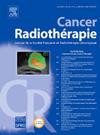Prise en charge de la gynécomastie à l’ère des inhibiteurs des récepteurs aux androgènes chez les patients atteints de cancer de la prostate
IF 1.4
4区 医学
Q4 ONCOLOGY
引用次数: 0
Abstract
This review aims to evaluate the incidence, clinical impact, and available therapeutic options for the management of gynecomastia induced by hormonal therapy, particularly in the era of androgen receptor pathway inhibitors, in patients with prostate cancer. We analysed data from clinical trials evaluating the incidence of gynecomastia under androgen receptor pathway inhibitors and the efficacy of both prophylactic and curative strategies, primarily tamoxifen and male breast radiotherapy, in patients receiving bicalutamide. Androgen receptor pathway inhibitors monotherapy is associated with high rates of gynecomastia (34 to 55 %), whereas combining androgen receptor pathway inhibitors with chemical castration significantly reduces this risk. Prophylactic tamoxifen significantly decreases gynecomastia incidence (down to 10 % versus 73 % without treatment) with good overall tolerance; prophylactic breast radiotherapy also shows efficacy. In the curative setting, tamoxifen appears more effective than radiotherapy, while surgery remains an invasive fallback option. However, extrapolating results obtained with bicalutamide to second-generation androgen receptor pathway inhibitors remains uncertain due to pharmacological and clinical differences. Gynecomastia could become a major complication of androgen receptor pathway inhibitors monotherapy. To date, tamoxifen and prophylactic breast radiotherapy are the most validated strategies, with the former appearing more effective. Further studies are needed to confirm their specific efficacy and safety in patients treated with androgen receptor pathway inhibitors.
前列腺癌患者雌激素受体抑制剂时代的妇科管理
本综述旨在评估激素治疗(特别是雄激素受体途径抑制剂时代)在前列腺癌患者中引起的男性乳房发育症的发生率、临床影响和可用的治疗选择。我们分析了来自临床试验的数据,评估了雄激素受体途径抑制剂治疗下男性乳房发育症的发生率,以及预防和治疗策略(主要是他莫昔芬和男性乳房放疗)在接受比卡鲁胺治疗的患者中的疗效。雄激素受体途径抑制剂单药治疗与男性乳房发育症的高发生率相关(34 - 55%),而雄激素受体途径抑制剂联合化学阉割可显著降低这一风险。预防性他莫昔芬可显著降低男性乳房发育症的发生率(降低至10%,而未经治疗的发生率为73%),总体耐受性良好;预防性乳房放射治疗也显示出疗效。在治疗方面,他莫昔芬似乎比放疗更有效,而手术仍然是一种侵入性的后备选择。然而,由于药理学和临床差异,将比卡鲁胺获得的结果外推到第二代雄激素受体途径抑制剂仍然不确定。男性乳房发育症可能成为雄激素受体途径抑制剂单药治疗的主要并发症。迄今为止,他莫昔芬和预防性乳房放射治疗是最有效的策略,前者似乎更有效。需要进一步的研究来证实它们在雄激素受体途径抑制剂治疗患者中的特异性疗效和安全性。
本文章由计算机程序翻译,如有差异,请以英文原文为准。
求助全文
约1分钟内获得全文
求助全文
来源期刊

Cancer Radiotherapie
医学-核医学
CiteScore
2.20
自引率
23.10%
发文量
129
审稿时长
63 days
期刊介绍:
Cancer/radiothérapie se veut d''abord et avant tout un organe francophone de publication des travaux de recherche en radiothérapie. La revue a pour objectif de diffuser les informations majeures sur les travaux de recherche en cancérologie et tout ce qui touche de près ou de loin au traitement du cancer par les radiations : technologie, radiophysique, radiobiologie et radiothérapie clinique.
 求助内容:
求助内容: 应助结果提醒方式:
应助结果提醒方式:


